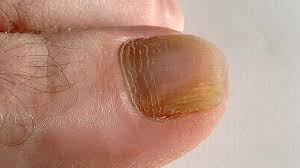What's in this article?
What is Fungal Nails?
Nail fungus is a common condition that begins as a white or yellow spot under the tip of your fingernail or toenail. As the fungal infection goes deeper, nail fungus may cause your nail to discolor, thicken and crumble at the edge. It can affect several nails but usually not all of them.
If your condition is mild and not bothering you, you may not need treatment. If your nail fungus is painful and has caused thickened nails, self-care steps and medications may help. But even if treatment is successful, nail fungus often comes back.
Nail fungus is also called onychomycosis (on-ih-koh-my-KOH-sis) and tinea unguium. When fungus infects the areas between your toes and the skin of your feet, it’s called athlete’s foot (tinea pedis).
Causes Fungal Nails
In normal, healthy people, fungal infections of the nails are most commonly caused by fungus that is caught from moist, wet areas. Communal showers, such as those at a gym or swimming pools, are common sources. Going to nail salons that use inadequate sanitization of instruments (such as clippers, filers, and foot tubs) in addition to living with family members who have fungal nails are also risk factors. Athletes have been proven to be more susceptible to nail fungus. This is presumed to be due to the wearing of tight-fitting, sweaty shoes associated with repetitive trauma to the toenails. Having athlete’s foot makes it more likely that the fungus will infect your toenails. Repetitive trauma also weakens the nail, which makes the nail more susceptible to fungal infection.
Elderly people and people with certain underlying disease states are also at higher risk. These include anything that impairs your immune system can make you prone to getting infected with the fungus. These include conditions such as AIDS, diabetes, cancer, psoriasis, or taking any immunosuppressive medications like steroids.
Signs & Symptoms of Fungal Nails
If you get nail fungus, you’re likely to see one or more of the following changes to your nails:
- Part of a nail turns white, yellow, brown, or another color. At first, you may just see a spot of discoloration at the tip of your nail. Without treatment, this discoloration may spread, covering more of the nail.
- Debris builds up under the nail
- A nail begins to lift up, so it’s no longer firmly attached to the finger or toe.
- A nail turns white, and the surface of the nail may feel soft, dry, and powdery. The nail also thins, so you may be able to scrape off the nail.
- Nails thicken and turn yellow or brown, often this affects all of the fingernails.
- A nail splits or crumbles
Having nail fungus is usually painless. At least, it’s painless in the beginning. If you put off getting treatment, however, the fungus can grow. When the fungus worsens on toenails, wearing shoes can become painful.
If you see any changes to a nail, you should see a dermatologist. When caught early, nail fungus may clear with treatment applied to the nail. As the fungus grows, it becomes more difficult to clear the infection.
How Do I Know If I Have a Fungal Nail Infection?
Because other infections can affect the nail and mimic symptoms of fungal nail infection, the only way to confirm a diagnosis is to see a doctor. They will take a scraping of the nail and look under a microscope for signs of a fungus. In some cases, your doctor may have to send the sample to a lab for analysis and identification.
Treatment for Fungal Nails
Keeping nails trimmed and filed can help to reduce the amount of fungus in the nails and is highly recommended. This also provides pain relief when thickened nails cause pressure-related pain.
Creams and other topical medications have traditionally been less effective against nail fungus than oral medications. This is because nails are too hard for external applications to penetrate. It is also cumbersome to adhere to topical medication regimens. Oftentimes, these medications require daily applications for a period of time up to one year to see results. One of the major advantages of topical treatment is the minimal risk for serious side effects and drug interactions compared to oral therapy.
Prescription topical medications for fungal nails include the following:
Ciclopirox (Penlac) topical solution 8% is a medical nail lacquer that has been approved to treat finger or toenail fungus that does not involve the white portion of the nail (lunula) in people with normal immune systems. It only works about 7% of the time. The medication is applied to affected nails once daily for up to one year. The lacquer must be wiped clean with alcohol once a week. There is some evidence that using an antifungal nail lacquer containing amorolfine can prevent reinfection after a cure, with a success rate of about 70%. However, this drug is currently unavailable in the United States.
Efinaconazole (Jublia) is a medication that was approved in 2014. It is a topical (applied to the skin) antifungal used for the local treatment of toenail fungus due to two most common fungal species affecting nails (Trichophyton rubrum and Trichophyton mentagrophytes). Once-daily application is required for 48 weeks. The most common side effects of Jublia are ingrown toenails and application site dermatitis and pain.
Tavaborole (Kerydin) is another new medication that is indicated for onychomycosis of the toenails. This medicine has the same indication as efinaconazole. It also requires application once daily for 48 weeks. Common side effects of Kerydin are similar to those of Jublia.






Leave a Comment